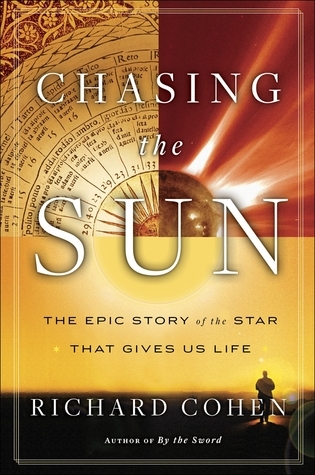Chasing the Sun

ISBN: 9781400068753
Richard A. Cohen endeavors, in this 2010 work, to tell the reader all about the sun. The only issue is, Richard A. Cohen does not sufficiently get out of the way enough to tell us about the sun. Rather, he tells us what he thinks about the sun. It is still an interesting read, but it is not as scientific as it would like to be.
Many reviewers discuss this work and how it tends to be Western culture dominant. There is certainly a smattering of that present in the text. The first section of the book discusses eclipses in no small way, and presents evidence that the cultural fear of them ingrained in other native beliefs appears to evidently hold some weight. Certain people die. Unnatural births occur. Then, Cohen goes on to state that these beliefs are superstition and baseless and that modern science clearly is superior. It is a very strange kind of tension and one that seems to want to validate the older meanings of what an eclipse entails while at the same time trying to appease modern rationalists and thereby refuting those earlier assertions.
The next pieces of the book go on to discuss artists, sun tans, and more than a few adventures to speak with people concerning solar power and climate change. Again, many reviewers have noted that this work “dismisses climate change.” This was not evident from reading it. Rather, the cause of climate change is debated and the uncertainty of what drives it is analyzed. Apparently, the same scientific modern rationalist crowd that Cohen seems to be trying to please is off-put because the conclusions do not support categorically the main narrative that climate change is man-made only and the reason for atmospheric change.
The stronger parts of the book speak about the solar cycles concerning the sun spots and what they are and how they work. This, mixed in with some tantalizing clues about how certain kinds of ancient literature might have been tellings concerning the movement of the ancient night sky are the tidbits that make the read worthwhile. The crumbs like these, although invaluable diamonds, though, are a bit too scarcely scattered among fields of debris. While it is interesting to learn about say, Louis the Sun King and Cohen’s ascent up Mt. Fuji to see the sunrise, it is less titillating to read about how great science is. The narrative is evocative of a jigsaw puzzle, and one sometimes gets the impression that Cohen was running out of things to talk about concerning the sun and so simply decided to discuss aesthetics around the sun instead or modern rationalism. Of course, it could also have been some ploy to sell books to a wider audience since artistic sorts are not usually science-y sorts. The net effect, however, is to alienate the voice of the narrative from being what feels like what would make it authentic. Who cares why people get sun tans? Tell us more about your own adventures to India. One of these facts can be deduced from Wikipedia, the other requires us to probably purchase the work of the author. Guess which one is worth more of the price of admission?
In the scientific landscape of the sun post 2010, there have been many new assertions and discoveries. Cohen’s book might best be read as a kind of cultural monument to what we thought we knew about the sun up to about 2010 if the reader is looking for the scientific reason for taking the time to comb its pages. For the mythologist, take a pass on this book. For those looking for a basic adventure concerning the author and the sun, well, there are some worthwhile points in his experience–just do not get too hungry for this kind of narrative. There are crumbs, but little by way of red meat.